Ahsan A. (ed.) Evaporation, Condensation and Heat transfer
Подождите немного. Документ загружается.


Fluid Mechanics, Heat Transfer and Thermodynamic Issues of Micropipe Flows
519
Fig. 2. Variation of radial distributions of axial velocity with Re, d and ε
*

Evaporation, Condensation and Heat Transfer
520
and power loss (Ω
loss
) (Fig. 5) values. Computations indicated that surface heat flux had no
affect on VP distribution, hydrodynamic boundary layer development, C
f
*
and Ω
loss
variations; thus the representative plots (Figs. 2-5) clarify the combined roles of wall
roughness (ε), micropipe diameter (d) and Reynolds number (Re) on the momentum
characteristics of laminar-transitional flow. The radial distributions of axial velocity for the
micropipe diameters of d=1.00, 0.75, 0.50 mm, for the Reynolds numbers of Re=100, 500,
1000, 1500, 2000 and for the non-dimensional surface roughness range of ε
*
=0.001-0.01 is
shown in Fig. 2. In the complete ε
*
and d ranges taken into consideration, the VPs of the
Re=100 scenario shown no sensible shift from the characteristic laminar profile (Eq. (14a));
where the corresponding boundary layer parameters (Fig. 3) show only slight deviations
from the characteristic laminar data. As the shape factor and intermittency for the micropipe
with d=1.00 mm are calculated as H=3.347→3.331 & γ=0.008→0.018 (ε
*
=0.001→0.01), those
of d=0.75 mm come out to be H=3.346→3.328 & γ=0.009→0.019 and for d=0.50 mm they
become H=3.344→3.324 & γ=0.010→0.022. Friction coefficient based viscous behavior of the
flow is significant owing to its straight interrelation with the generation of frictional entropy
(Eq. 11). As displayed in Fig. 4, higher surface roughness values elevates the frictional
actions in micropipe flows, such that at the low Reynolds number of at Re=100, the rise of ε
*
from 0.001 to 0.01 manipulates the C
f
*
to grow by ~0.7% and ~0.9% for the micropipes with
d=1.00 mm and d=0.50 mm respectively. Velocity profiles are more apparently affected by
roughness and diameter at higher Reynolds numbers (Fig. 2).
The lowest surface roughness of ε
*
=0.001 result in, although poorer but identifiable,
variations in the flow domain at Re=500, where the impact becomes more detectable at
lower d with the interpreting data of H=3.291→3.273 & γ=0.042→0.052 (d=1.00→0.50 mm)
(Fig. 3). The response of friction coefficient, to elevated surface roughness, becomes as well
more rational at higher Re; more particular indicating puts forward that as C
f
*
is evaluated
as 1.006→1.013 (ε
*
=0.001→0.01), 1.030→1.065 and 1.091→1.195 for Re=100, 500 and 1500
respectively at d=1.00 mm, the corresponding values rise to C
f
*
=1.008→1.016, 1.038→1.082
and 1.114→1.246 at d=0.50 mm. The growing impact of surface roughness on friction
coefficient at higher Reynolds numbers and lower micropipe diameters can evidently be
inspected from these figures. Similar to the present findings, the augmenting role of
roughness on friction coefficient with Reynolds number was as well documented by Vicente
et al. (2002), Guo & Li (2003), Engin et al. (2004), Wang et al. (2005), Petropoulos et al. (2010)
and Almeida et al. (2010).
Fig. 3. Variation of H and γ with Re, d and ε
*
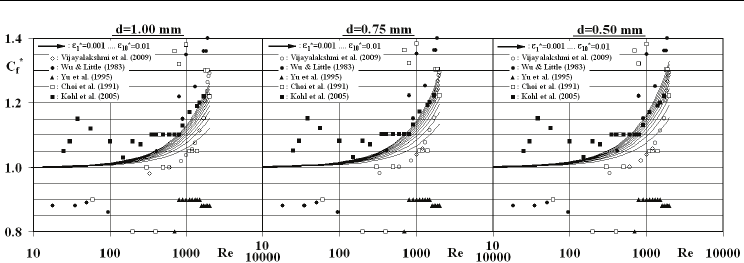
Fluid Mechanics, Heat Transfer and Thermodynamic Issues of Micropipe Flows
521
Fig. 4. Variation of C
f
*
with Re, d and ε
*
On the other hand, with the increase of Reynolds number the variation rates in C
f
, at
different micropipe diameter cases, become stronger with the particular values of 3.4→4.2%
(d=1.00→0.50 mm), 6.6→8.1%, 9.6→11.9% and 12.4→15.2% for Re=500, 1000, 1500 and 2000.
Renaud et al. (2008), Almeida et al. (2010) and Parlak et al. (2011) also shown the grow of
frictional activity in micropipes with lower diameters. As shown in Fig. 4, as the
experimental records of Yu et al. (1995) were below the laminar theory for 100<Re<2000, Wu
& Little (1983), Choi et al. (1991) and Kohl et al. (2005) also experimentally determined
elevated friction coefficients for Re>500. Moreover, in the particular surface roughness case
of ε
*
=0.002, comparably sharper increase rates in C
f
*
for Re>700, were experimentally
recorded by Vijayalakshmi et al. (2009). The growing influence of surface roughness on the
flow pattern (VPs) with lower micropipe diameter and higher Reynolds number is also
demonstrated in Fig. 2. At higher ε
*
and Re and at lower d, the gap between the U
c
/U
o
ratios
and the traditional data of U
c
/U
o
=2.0 (Eq. (14a)) increases. In addition to these, transition
phenomena has been in the research agenda of several scientists and associating the
augmentation of friction coefficient with the transition onset has become a tradition. Several
researchers (Wu & Little, 1983, Obot, 2002, Vicente et al., 2002, Guo & Li, 2003, Kandlikar et
al., 2003), performing experimental and numerical studies, recognized a 10% rise in C
f
(C
f
*
=1.1), above the traditional laminar formula of Eq. (17b), as an indicator for the
transitional activity. The present computations pointed out that the laminar character
continued up to the Reynolds number of Re=600 for the complete micropipe diameter
(d=1.00-0.50 mm) and non-dimensional surface roughness (ε
*
=0.001-0.01) ranges considered
with C
f
*
values being lower than 1.1. The transitional Reynolds numbers appear as
Re
tra
≈1656→769 (ε
*
=0.001→0.01), 1491→699 and 1272→611 for d=1.00, 0.75 and 0.50 mm,
indicating the crucial authority of surface roughness on the transition process. These results
clearly identify that micropipe diameter and roughness accelerates transition to lower
Reynolds numbers. At the transition onset, the boundary layer approach (Eqs. (16a-b)) puts
forward that the transitional shape factor and intermittency values appear in the contracted
intervals of H=3.135-3.142 and γ=0.132-0.135 (Fig. 3). These ranges not only put forward that
as shape factor falls, intermittency rises in due course of the shift from laminar character but
also suggest the suitability of determining the transition onset by solely evaluating the
intermittency information; in the current study γ=~0.135 appears as the marker datum. It
can be concluded with implicit trust that the decrease of H and U
c
/U
o
and the
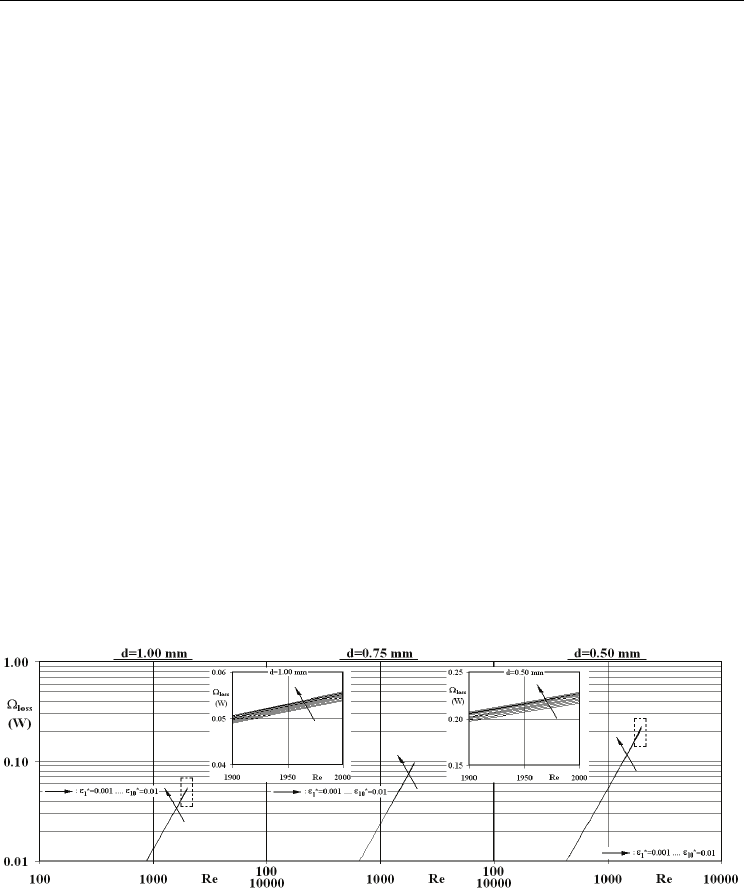
Evaporation, Condensation and Heat Transfer
522
complementary increase of C
f
*
and γ are scientifically dependable indicators for the early
stages of transitional activity in the fluid domain in micropipe flows. Besides, the present
findings on the transitional Reynolds numbers are scientifically analogous with those of Wu
& Little (1983) (for a range of ε
*
⇒ Re
tra
≈510-1170), Obot (2002) (smooth pipe ⇒ Re
tra
≈2040)
and Kandlikar et al. (2003) (for ε
*
≈0.003 ⇒ Re
tra
≈1700).
The concept of power loss (Ω
loss
) can be considered as not only a terminological but also a
scientific link among the frictional activity and the 2
nd
law characteristics of micropipe
flows; thus the individual and combined actions of Re, d and ε
*
on Ω
loss
and the so
occurring deviations are presented in Fig. 5. It can clearly be inspected from the figure
that power loss values grow with Reynolds number. Computations more explicitly
defined that, the partial derivative of
loss
∂Ω /Re∂ comes out to be 5.34→1.33
(d=0.50→1.00 mm), 10.8→2.69 and 21.8→5.40 (x10
-5
) at the Reynolds numbers of Re=500,
1000 and 2000 respectively. These numbers not only identify the non-linear dependence
among Ω
loss
and Re but also the rapid grow of Ω
loss
with higher Re and with lower d,
where the advanced micro attitude of the pipe diameter appears to more dominantly
characterize this interaction at elevated Reynolds numbers. Fig. 5 additionally reveals that
Ω
loss
gets the most remarkable values at the lowest micropipe diameter case of d=0.50 mm,
which can be attributed to the stronger frictional activity and the consequently enhanced
viscous shear stress (τ
rz
) values in the lower micropipe diameter scenarios with higher
surface roughness (Fig. 4). Power loss due to friction in laminar flow was as well
determined and reported by Koo & Kleinstreuer (2004), Morini (2005) and Celata et al.
(2006a,b). Being completely in harmony with the present evaluations on the power loss
mechanism, their computational and experimental findings not only exposed exponential
augmentations in Ω
loss
due to high Re but also pointed out the direct relation of viscous
dissipation with Reynolds number.
Fig. 5. Variation of Ω
loss
with Re, d and ε
*
The zoomed plots for the micropipe diameter cases of d=1.00 & 0.50 mm demonstrate
additional information regarding the motivation of power loss values with surface
roughness. Through comparisons among the scenario based computational outputs, the
mechanism can be detailed with scientific accountability. The power loss values of the
limiting surface roughness cases are reviewed with
**
loss loss
ε 0.01 ε 0.001
/
==
ΩΩ, which results in

Fluid Mechanics, Heat Transfer and Thermodynamic Issues of Micropipe Flows
523
the ratios of 1.002→1.004 (d=1.00→0.50 mm), 1.009→1.014 and 1.035→1.055 at the Reynolds
numbers of Re=500, 1000 and 2000 respectively. The growing action of surface roughness on
power loss with lower micropipe diameter and higher Reynolds number can clearly be seen
from these numbers.
3.2 Heat transfer issues
The primary consequence of the transfer of energy to fluid flow comes into sight through
the response of the thermal structure, namely the temperature profile (TP) development,
of the concept domain. Since the momentum and energy mechanisms considerably
interact, the applied wall heat flux and viscous dissipation based energy loss (Ω
loss
) on the
solid walls simultaneously and strongly affect the TP in the fluid domain. Due to these
facts and not only to identify the individual and combined roles of Reynolds number,
micropipe diameter, surface roughness and heat flux on the thermal features of micropipe
flows but also to display the deviation of the evaluated characteristics from the traditional
laminar layout, Fig. 6 covers the TPs of various scenarios in conjunction with the laminar
Constant Heat Flux (CHF) formula of Eq. (15) (Incropera & DeWitt, 2001). The figure
shows that, in the complete Re and ε
*
cases taken into consideration, the TP of the
micropipe with d=1.00 mm are almost identical. The independent nature of the TPs from
ε
*
can as well be identified through the non-dimensional temperature gradients (ndTG) on
the pipe-surface
()
()
rR
T/ r
=
∂∂
. Such that, as the ndTG of the Reynolds number cases of
Re=500, 1000 and 2000 get the values of ndTG=6.01, 5.99, and 5.91 (x10
-3
) at the highest
heat flux level of 2000 W/m
2
, they drop down to ndTG=3.00, 2.98 and 2.90 (x10
-3
) at the
lowest level of 1000 W/m
2
.
There exists almost a two times gap among the ndTG values of the limiting heat flux
applications, where the grow of the ndTG with
''
q can also be recognized as a result of
enhanced heat addition on the walls of the thermal system. However, due to the
promoted power loss values (Fig. 5) in the scenarios with higher Re and ε
*
and lower d,
the comparison of the ndTGs among the limiting heat flux scenarios at d=0.50 mm bring
about the ratios of
() ()
22
r R q"=2000 W/m r Rq"=1000 W/m
T/ r / T/ r
==
∂∂ ∂∂ =~2.00 (Re=500), ~2.08
(Re=1000) and ~2.37 (Re=2000), evidently pointing out the synergy of Re on the affects of
''
q on ndTG. On the other hand, ndTGs are evaluated to become moderate with the
increase of mass flow rate, more specifically with Reynolds number, depending on the
promoted competence of energy embracing in those scenarios. Computations put forward
that the impact of surface roughness on the TP development becomes stronger at lower
micropipe diameters, more explicitly with micro-activity. For the lowest diameter of
d=0.50 mm and at the highest heat flux condition of
''
q =2000 W/m
2
, the plotted styles in
Fig. 6 clarify that in the Reynolds number cases Re=500, 1000 and 2000 ndTG attains the
values of 2.93→2.98 (x10
-3
) (ε
*
=0.001→0.01), 2.82→2.91 (x10
-3
) and 2.31→2.59 (x10
-3
)
respectively. In the heat flux application of
''
q
=1000 W/m
2
, these gradients decrease
down to ndTG=1.47→1.48 (x10
-3
), 1.36→1.40 (x10
-3
) and 0.98→1.09 (x10
-3
) at the identical
Reynolds numbers. The increase of the ndTG with ε
*
is an evidence of the augmenting
role surface roughness on heat transfer.
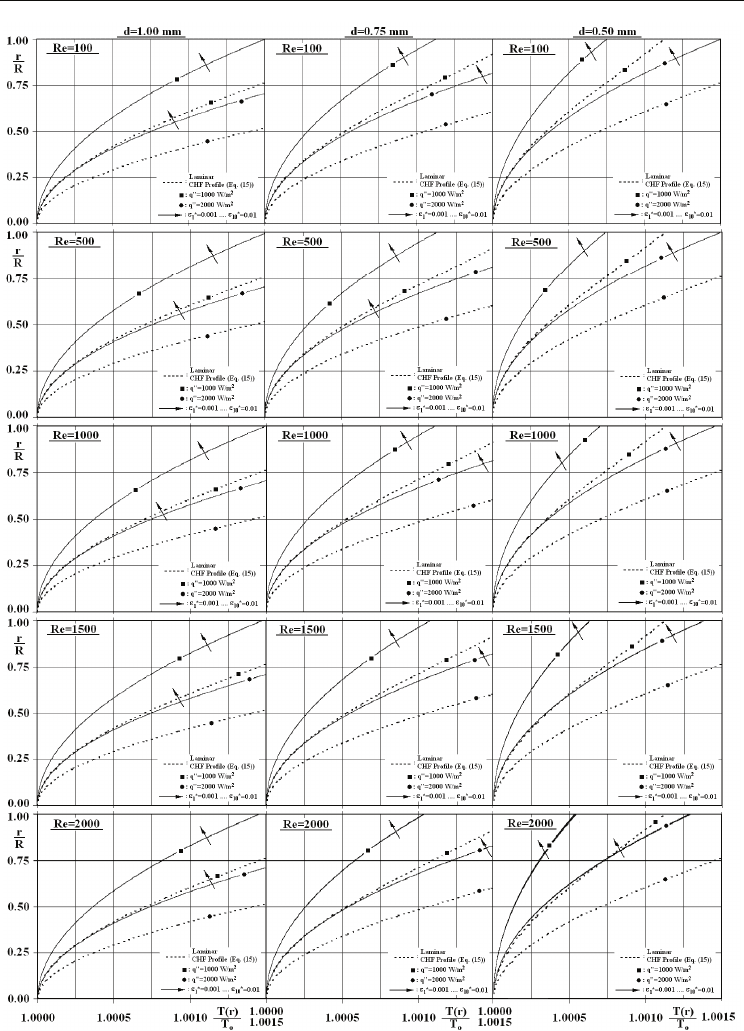
Evaporation, Condensation and Heat Transfer
524
Fig. 6. Variation of radial distributions of temperature with Re, d, ε
*
and q”
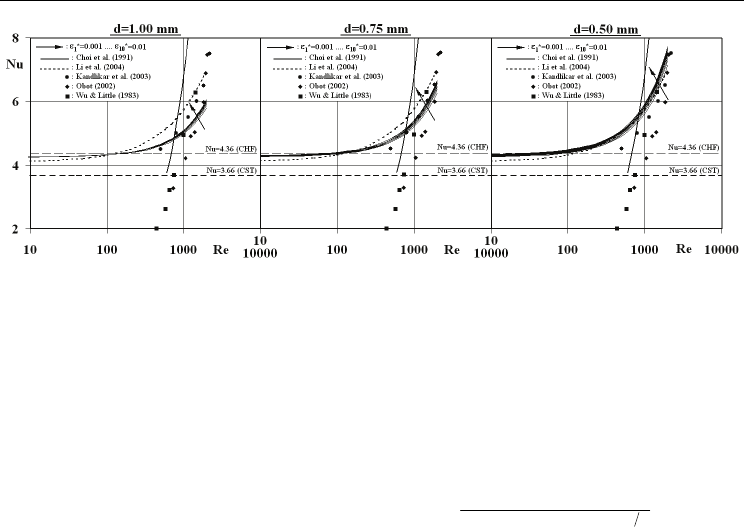
Fluid Mechanics, Heat Transfer and Thermodynamic Issues of Micropipe Flows
525
Fig. 7. Variation of Nu with Re, d and ε
*
Figure 7 displays the variation of Nusselt number with Reynolds number for various
micropipe diameter (d=1.00-0.50 mm) and surface roughness (ε
*
=0.001-0.01) alternatives; the
custom criteria of constant surface temperature (Nu
CST
=3.66) and constant heat flux
(Nu
CHF
=4.36) for laminar flow are as well supplied in the graph. Moreover, the empiric
equation of Choi et al. (1991) (Eq. (19a)) and Li et al.’s (2004) analogy (Eq. (19b)) are also
plotted for comparison purposes.
1.17 0.333
Nu 0.0000972 * Re * Pr=
()
23
0.14*d/L*Re*Pr
Nu 4.1
1 0.05* d/L*Re*Pr
=+
+
(19a-b)
Computations indicated an almost constant Nusselt number of Nu=4.25 for Re≤100 in the
complete micropipe diameter and surface roughness ranges; Vicente et al. (2002) as well
reported for Re<700 that Nusselt number remained stable around Nu=~4.36. The present
outcome is not only analogous with the traditional laminar values of Nu
CST
and Nu
CHF
but
also identifies the thermally ineffective presence of the d and ε
*
. Above Re=100, heat
transfer rates are motivated by flow velocity such that Nusselt numbers determined to
increase with Reynolds number. Particularly it can more easily be clarified for the d=1.00
mm case that the roughness range (ε
*
=0.001-0.01) based average Nu
Re=100
/Nu
Re=10
,
Nu
Re=500
/Nu
Re=100
, Nu
Re=1000
/Nu
Re=500
and Nu
Re=2000
/Nu
Re=1000
ratios attain the values of
1.016, 1.073, 1.090 and 1.180, where these figures become 1.021→1.030, 1.094→1.133,
1.114→1.156 and 1.223→1.294 for d=0.75→0.50 mm. These figures clearly identify that the
heat transfer mechanism is subjected to the non-linear and also concurrently growing
influence of Reynolds number with the micropipe diameter. Choi et al. (1991), Obot
(2002), Vicente et al. (2002) and Li et al. (2004) also recorded elevated heat transfer rates
with Reynolds number. As the empiric equation (Eq. (19a)) of Choi et al. (1991) matches
with the present outputs only in the narrow Reynolds number band of 700<Re<900, the
analogy (Eq. (19b)) of Li et al. (2004) resemble similar outputs with the current evaluations
in the Reynolds number range of Re>300 for the micropipes with the diameters of d=0.50-
0.75 mm. Moreover, the experimental data of Wu & Little (1983) (for Re≥1000), Obot
(2002) (for Re≥1000) and Kandlikar et al. (2003) (for Re≥500) are reasonably in harmony
with the current numerical outputs. Figure 7 further demonstrates the enhancing function
surface roughness on Nusselt number, where Wu & Cheng (2003) and Kandlikar et al.

Evaporation, Condensation and Heat Transfer
526
(2003) also notified the rise of heat transfer rates with surface roughness through their
experimental works. The present calculations further denoted the rising impact of surface
roughness on Nusselt number at lower micropipe diameters and higher Reynolds
numbers. It can more particularly be clarified that, at the lowest micropipe diameter case
of d=0.50 mm, the Nu
ε
*=0.01
/Nu
ε
*=0.001
ratio attains the values of 1.023 (Re=100), 1.039
(Re=500), 1.056 (Re=1000) and 1.082 (Re=2000), whereas the proportions become 1.011,
1.026, 1.040 and 1.062 for d=0.75 and 1.002, 1.012, 1.025 and 1.046 for d=1.00 mm. On the
other hand, the influence of the transition mechanism on the heat transfer rates can be
signified through comparisons among the Nu values (Nu
tra
) computed at Re
tra
and the
laminar value (Nu
lam
=4.25) attained at Re<100. The encouraged activity with the rates of
41.1→21.6% (ε
*
=0.001→0.01) at d=0.50 mm, 33.2→18.5% at d=0.75 mm and 29.8→15.1% at
d=1.00 mm, designate that Nu at the transition onset grow by 1.22→1.15 (d=0.50→1.00
mm) for ε
*
=0.01 and by 1.41→1.30 for ε
*
=0.001. It can further be deduced from these
evaluations that, the accelerated transition mechanism to considerably low Re
tra
with
higher surface roughness suppresses the thermal activity associated with transition;
besides in fluid domains with lower micropipe diameters, the transitional heat transfer
levels are encouraged with further synergy.
3.3 Thermodynamic issues
The concepts regarding the fluid mechanics and heat transfer mechanisms of micropipe
flows are not only significant in their classified scientific research frame, but they are also
recognizable due to their fundamental stance in developing the theoretical background for
the thermodynamic investigations. Having identified the broad panorama of the
momentum and thermal characteristics, the thermal, frictional and total entropy generation
values and Bejan number can be outlined and discussed to interpret the thermodynamic
issues and 2
nd
law mechanisms of micropipe flows.
Table 1 displays the variation of cross-sectional frictional entropy generation
()
'
ΔP
S values
with various Reynolds number, micropipe diameter, surface roughness and surface heat
flux scenarios. The tabulated values clearly identify for the complete ranges of Re, d and ε
*
that wall heat flux has almost no influence on frictional entropy generation, where this
outcome can be associated with the identical VP formation in different heat flux applications
(Fig. 2). Computations shown that microactivity, namely lower micropipe diameters,
encourage the frictional entropy generation values; this finding can scientifically be
interrelated with the augmentation of C
f
*
data (Fig. 4) with lower d. Hooman (2008) as well
perceived the growing role of lower micropipe diameter on frictional entropy generation
rates. The individual and combined roles of the acting parameters on frictional entropy
generation can scientifically be classified through the comparison strategy of
d 0.50mm d 1.00mm
''
ΔP ΔP
S/S
==
, which points out the complete surface heat flux range (
''
q =1000-2000
W/m
2
) averaged ratios of 4.001→4.001 (ε
*
=0.001→0.01), 4.002→4.007, 4.006→4.027 and
4.023→4.102 for Re=100, 500, 1000 and 2000 respectively. These figures clearly reveal that
the surface roughness and micropipe diameter are augmenting factors on frictional entropy
generation; moreover Reynolds number, or flow velocity, acts as a supporting-reagent on
the impact of d and
ε
*
on
'
ΔP
S .

Fluid Mechanics, Heat Transfer and Thermodynamic Issues of Micropipe Flows
527
Table 1. Variation of
'
ΔP
S with Re, d, ε
*
and q”
On the other hand,
'
ΔP
S
are investigated to increase with Re in the complete d range taken into
consideration. The systematically gathered numerical outputs identified the linear variation of
'
ΔP
S with Re on logarithmic scale. The analysis confirmed the exciting impact of lower d on
the ascend of
'
ΔP
S with Re, where the representative
'
ΔP
lo
g
S/lo
g
Re∂∂ ratios are evaluated as
2.012, 2.009 and 2.008 for d=0.50, 0.75 and 1.00 mm respectively. The tabulated values in Table
1 further exhibits that
'
ΔP
S
are also manipulated by ε
*
. The outputs of the limiting scenarios
can be compared with the ratio of
**
0.01 0.001
''
ΔP ΔP
S/S
εε
==
, which results in the growing rates of
1.000→1.000 (Re=100) (d=1.00→0.50 mm), 1.002→1.003 (Re=500), 1.008→1.014 (Re=1000) and
1.034→1.055 (Re=2000). The evidently more definite impact of
ε
*
on
'
ΔP
S
at higher Re and
lower d can be noticed from these proof; however they must still be labelled as originated from
the secondary-sort influence of surface roughness on frictional entropy.
The thermal distortions, in the fluid domain, or the strong temperature gradients, especially
on the physical boundaries of the system, account for irreversibilites, which as a
consequence cause the loss of available energy or the decrease of thermal efficiency. The
defining scientific expression is widely accepted as the thermal entropy generation and it is
also known to considerably interrelate with the levels of Re, d,
ε
*
and
''
q . To identify the
influential intensities of the acting operational components on the cross-sectional thermal
entropy generation
()
'
ΔT
S , Table 2 is structured. The temperature profile characteristics and
the local values of temperature in the fluid domain can computationally (Eq. (11a)) be
considered as the sources of
'
ΔT
S ; however the previous discussions on T(r) (Fig. 6) clearly
designated the significant manipulation capabilities of Reynolds number, micropipe
diameter, surface roughness, and surface heat flux on TP development. The superior
'
ΔT
S in
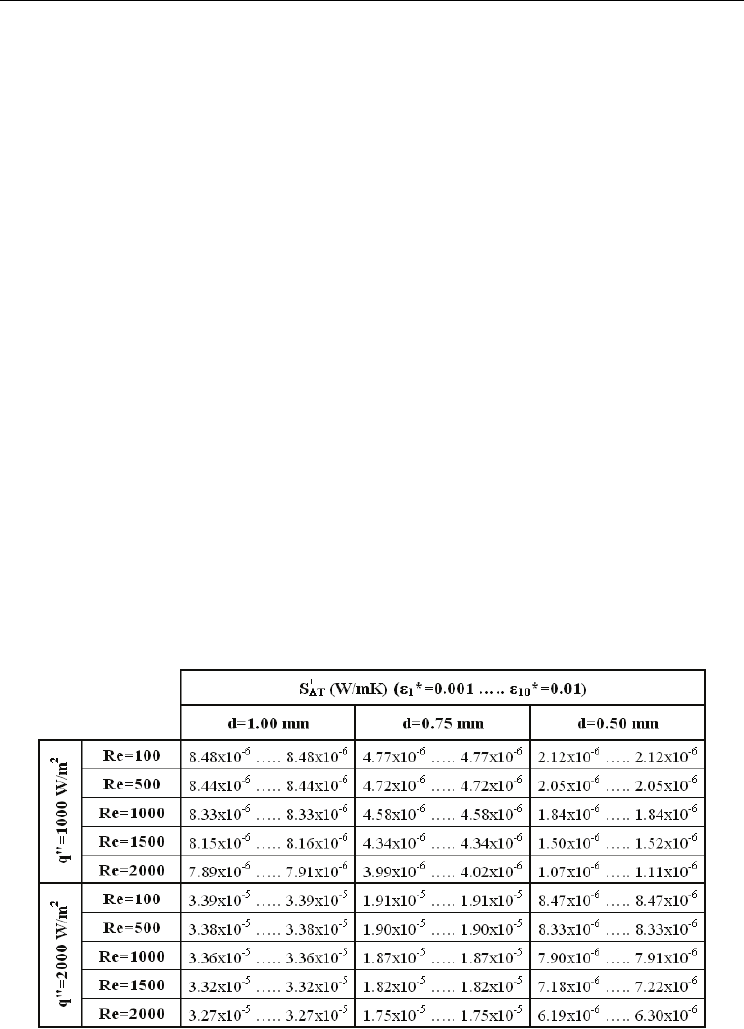
Evaporation, Condensation and Heat Transfer
528
micropipes with larger diameters can be inspected from the tabulated data. As the scientific
explanation can be interpreted through the stronger temperature gradients (Fig. 6) with
higher d, numerical comparisons identify additional valuable information. In the highest
heat flux application of
''
q =2000 W/m
2
the complete surface roughness range (ε
*
=0.001-
0.01) averaged
d 1.00mm d 0.50mm
''
ΔT ΔT
S/S
==
ratio comes out to be 3.998 (Re=100), 4.056 (Re=500),
4.249 (Re=1000) and 5.241 (Re=2000); but they decrease down to 4.003, 4.120, 4.531 and 7.267
as the imposed flux is lowered to
''
q =1000 W/m
2
. These proportions clearly show that the
physical measures in microflow systems can become comprehensively dominant on the
thermal entropy generation characteristics especially with lower heat flux applications and
in scenarios with higher flow velocity or mass flow rate. Table 2 additionally illustrates the
encouraging attempts of
''
q
on
'
ΔT
S
, which directly originates from the stronger
temperature gradients. Computations indicated the
"2"2
''
ΔT ΔT
q 2000W/m q 1000W/m
S/S
==
ratios
of 3.996, 4.005, 4.031 and 4.142 at Re=100, 500, 1000 and 2000 for d=1.00 mm; whereas these
figures rise to 3.998→4.001, 4.017→4.068, 4.080→4.298 and 4.369→5.743 for d=0.75→0.50
mm. These figures indicate the supporting action of lower d and higher Re on the
''
q -
'
ΔT
S
interaction. From surface roughness point of view, the tabulated data summarize the almost
insensible affects of
ε
*
on
'
ΔT
S
, especially in the micropipes with d=1.00 mm & 0.75 mm.
Although very minor when compared to those of d, Re and
''
q , surface roughness comes
out to evoke its potential on thermal entropy generation in the micropipe diameter case of
d=0.50 mm and only for Re≥1500. Computations revealed the most remarkable
'
ΔT
S
manipulations due to
ε
*
in the scenario of Re=2000-
''
q
=1000 W/m
2
, where the
**
0.01 0.001
''
ΔT ΔT
S/S
εε
==
ratio come out as 1.044, 1.008 and 1.002 for d=0.50, 0.75 and 1.00 mm.
Table 2. Variation of
'
ΔT
S with Re, d, ε
*
and q”
